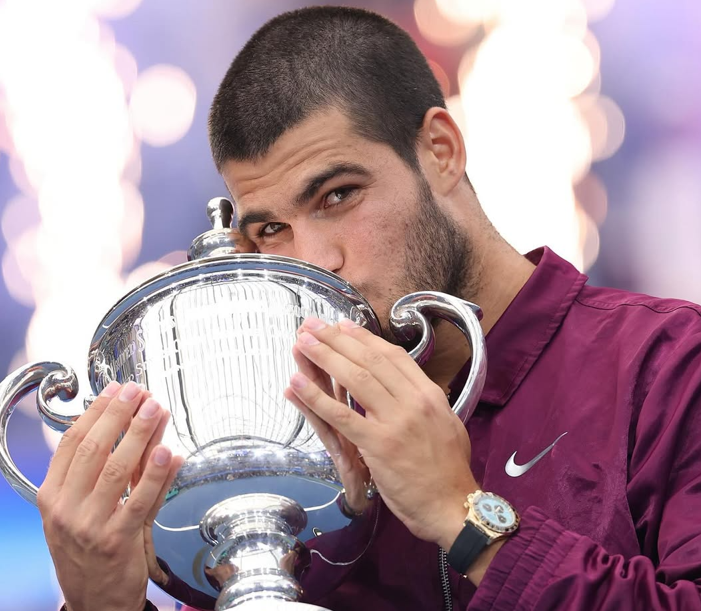All the Numbers Behind Carlos Alcaraz’s 2025 US Open Dominance

When Carlos Alcaraz and Jannik Sinner walked into the Arthur Ashe Stadium on Sunday for the 2025 US Open final, the 24,000-capacity venue was only two-thirds full. But hours later, when the Spaniard bagged his second title at Flushing Meadows, a packed Ashe stood on its feet to hail the ATP star with deafening applause, alongside POTUS Donald Trump, who made a special visit to the Big Apple for the occasion.
Alcaraz winning the US Open again by defeating Sinner in 6-2, 3-6, 6-1, 6-4 wasn’t just a thunderous testament to his incredible consistency and grit: It has also once again catapulted him to the top of the ATP rankings, and more! So, what did the Murcia, Spain, native achieve along with his sixth career Grand Slam title?
A rare six by 22 for Carlos Alcaraz
Carlos Alcaraz’s win in New York wasn’t just another trophy. It pushed his career total to six Grand Slams at age 22 (22 years, 125 days), a milestone that immediately invited historical comparison. By winning in Flushing Meadows, he joined an uber-elite club of players who hit half a dozen majors before their 23rd birthday. ATP’s media notes and contemporary coverage further underline that only the most precocious champions have managed similar tallies so young, a list which includes generational stars like Bjorn Borg and Rafael Nadal.

via Imago
Credit - Instagram/US Open
The ATP’s official coverage and timeline place Carlos Alcaraz among names that dominated the early stages of their careers, and the event triggered an immediate stat line from ATP media showing where he sits in the “youngest to six slams” list. That context is important: The US Open win, being his sixth Grand Slam title already at 22, is not just a tally, it’s a trajectory. It maps onto careers that shaped eras. Moreover, making Alcaraz’s feat even more incredible is the fact that he took 18 Grand Slams to win six majors titles, a stat that matches the great Borg, and is ahead of John McEnroe (21) and Nadal (22).
The ATP’s age/achievement table and attendant reporting made clear how uncommon it is to accumulate half a dozen Slams so young; Borg’s blistering early run still sets the standard, and some outlets immediately called Alcaraz the second-youngest or third figure in different phrasings depending on how they counted exact days/ages.
Multi-surface mastery, revisited
One of the neatest things about Alcaraz’s résumé after the 2025 US Open is that those six majors aren’t concentrated on a single surface. He’s now accumulated multiple titles on clay (Roland-Garros), grass (Wimbledon), and hard courts (US Open), meaning real, repeated success across the full spectrum of Grand Slam surfaces. Tennis analytics and match logs show this is not “one of each” luck: Alcaraz now has multiple wins on all three surfaces, which places him in rarefied territory historically.
That multi-surface durability matters because it reduces the chance that the run is surface-specific fluke. It’s a technical and strategic signal: Movement, serve, shot-making, and tactical variety are all functioning at an elite level on grass, clay, and hard courts. Analysts have also pointed out how his game has evolved - the serve and forehand variety that might have been inconsistent in his teens matured into reliable weapons this season, letting him convert the small margins that decide major finals on different surfaces.
Fewest break-points faced en route to a major: A serving masterclass for Alcaraz
If the US Open win itself wasn’t impressive, Alcaraz’s numbers on serve were jaw-dropping. Stat compilers and specialist feeds reported that Alcaraz faced only ten break-points over the entire tournament, a figure some experts framed as the fewest faced by a men’s Slam champion since the modern stat era began and singled out Roger Federer’s 12-break-points figure at Wimbledon 2006 as the prior benchmark. For context: ten break-points faced over seven matches signals a hugely improved serve/return posture and is a tidy, readable stat that sums up how Alcaraz combined offense with service stability in New York.

via Imago
Credit - Instagram/Carlos Alcaraz
The stellar form carried Carlos all the way. Before the US Open final, Alcaraz had not dropped a set during the fortnight and had conceded remarkably few games across his runs. The ATP Tour noted before the final, “The Spaniard has not dropped a set through six matches in New York and has lost just 58 games in 18 sets, for an average of just more than three games per set. He has only needed two tie-breaks.” That raw figure became shorthand for “how untouchable he looked” in pre-final narratives.
The modern classic that is the Carlos Alcaraz-Jannik Sinner rivalry
Alcaraz and Sinner have now crossed paths at three Grand Slam finals during 2025 - Roland-Garros, Wimbledon, and the US Open. The sequence is historically unique in the Open Era: No men’s pairing had contested three majors’ finals against one another in the same calendar year before. Tournament fact pages and the Associated Press (and the US Open’s own “by the numbers” notes) flagged that stat immediately after the final.
It matters because the sample size (three finals between the same two players in one season) gives us an unusually pure rivalry data set to judge style matchups, tactical adjustments, and mental edge. Analysts noted how each final produced different patterns (long clay epics, a tight grass match, and the tactical/serve adjustments on hard court), which makes the trilogy both rare and instructive for talent development narratives.
Their unique rivalry also made up for a special statement from Alcaraz. “I'm seeing you more than my family,” joked the Spaniard after his 2025 US Open title win.
Subduing the reigning No. 1 to reclaim the top spot
One of the flashier, and less obvious, historical footnotes from 2025 is this: Carlos Alcaraz beat the official world No. 1 in multiple Grand Slam finals during the same season. In 2025, he beat Jannik Sinner (the ATP’s top-ranked player at the time of those finals) in at least two major finals (Roland-Garros and the US Open), which is exactly the sort of repeat “beat the sitting No. 1 in more than one major final” achievement that tennis statisticians treat as especially rare. Shadows of Rafael Nadal’s 2008 season, when Nadal beat Roger Federer, then the world No. 1, in multiple Grand Slam finals, tennis fans?
Carlos Alcaraz’s New York victory also sent him back to the ATP world No. 1, making him reach the top spot since 2023. What better way to finish the Flushing Meadows run?
Written by

Diptarko Paul